Story and photos by Shabna Ullah
With their crops already washed away and no means of earning a living, residents of the Mahaica Creek have nothing to do but sit and watch helplessly as the floodwater surrounding them continues to rise.
They told Stabroek News during a visit to the area yesterday that the situation would lead to “starvation” as they were already running out of food. Some residents said they were setting fishing seines in their yards to get a meal.
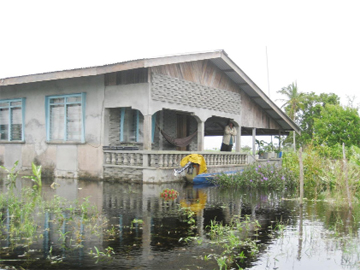
The residents who earn their living mainly through cash crop farming said they have had to pay high prices for basic vegetables that they normally have in abundance. “We lil savings that we had gon soon run out…”
The Civil Defence Commission and the Indian Arrival Committee distributed food hampers to the residents on Saturday which they were thankful for but said the items were all used up already.
The floodwaters have surpassed the level of the 2006 flood and residents are fearful that it would continue to rise even higher with the continued rainfall and with water still being released through the Maduni and the Lama sluices.
A resident said he and his family had gone “up the creek” on Sunday afternoon and they noticed that the Lama sluice was broken. They learnt that workers were trying to open it with an excavator when it collapsed. However, this newspaper was unable to confirm if that was indeed so although the residents had taken pictures of water gushing through the open door.
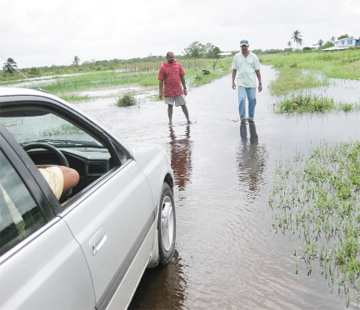
The residents said they felt the “May/June rain gon come and catch this flood so we don’t know when we gon get to plant again.”
They pointed out that they invested a lot of money in their crops and suffered tremendous losses after the water started to be released around Christmastime.
Most of the farmers said that they had gotten a few hours of work from the government’s excavator to build up and empoulder their land. They had even done extra work on their own and were certain that “rainfall alone don’t flood hey.”
They lamented that they should be properly compensated for their loss and demanded that they want to see a copy of the “conservancy act.”
The residents also argued that “when Georgetown flood government does attack the city council… but when the other areas get flood nobody must say anything. Dem don’t want Stabroek News to highlight how we suffering; dem only talking a set a nonsense on TV…”
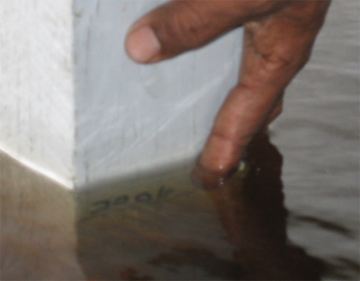
Further they said that a statement made by Minister of Agriculture, Robert Persaud on the “Flood Update” programme that their farms had already been flooded three weeks before the sluices were opened, was not true.
They said too that President Bharrat Jagdeo had promised them financial assistance when he visited the creek but the minister later issued a statement that no money would be given to farmers.
They pointed out that “with this situation we become like beggars but we don’t need government to give we anything; we does work hard fuh we living. Is just that in this situation everybody glad fuh anything.”
‘Lost corn and
husk’
Stabroek News caught up with large-scale cash crop farmer, Haimchand Mahadeo as he along with a worker; Nobert Khan, was reaping the last of his peppers in the floodwaters on a six-acre plot of land.
Over two weeks ago he along with seven workers filled almost 700 sand bags to empoulder the plot but said all his efforts went to waste on Friday evening when he lost the battle to the flood.
He admitted that he was putting himself at risk to invest more money in the plot but said the peppers were at a reaping stage and he could not bear to see that too go down the drain.
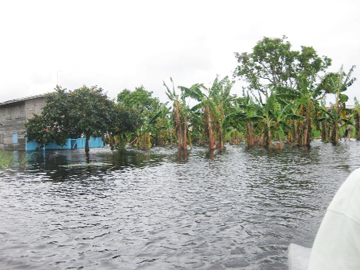
He said “I already lost a lot [24 acres of tomatoes, corilla, watermelon and other produce] and now I lost corn and I lost husk,” he said sadly.
He said he had asked for the services of an excavator to assist him in the battle to save the plot and Minister Persaud had given approval but the excavator left the area without him benefiting from it.
Another resident Naresh Bhagwandeo said he lost 25 acres of rice as well as his cash crop. He reiterated that farmers need to be compensated to get on their feet again as they suffered a lot of “blows” from the flood.
A section of his yard that is hardly affected by flooding was completely under water yesterday as he lamented his loss.
Hariram Ramkellawan, 61, of Big Biaboo and his wife Lakhrajie said yesterday that “every time we plant is more flood pun we. We can’t sleep at nights; we studying how much we loss. In we old days if we don’t get fuh wuk and save a dollar who gon give we?”
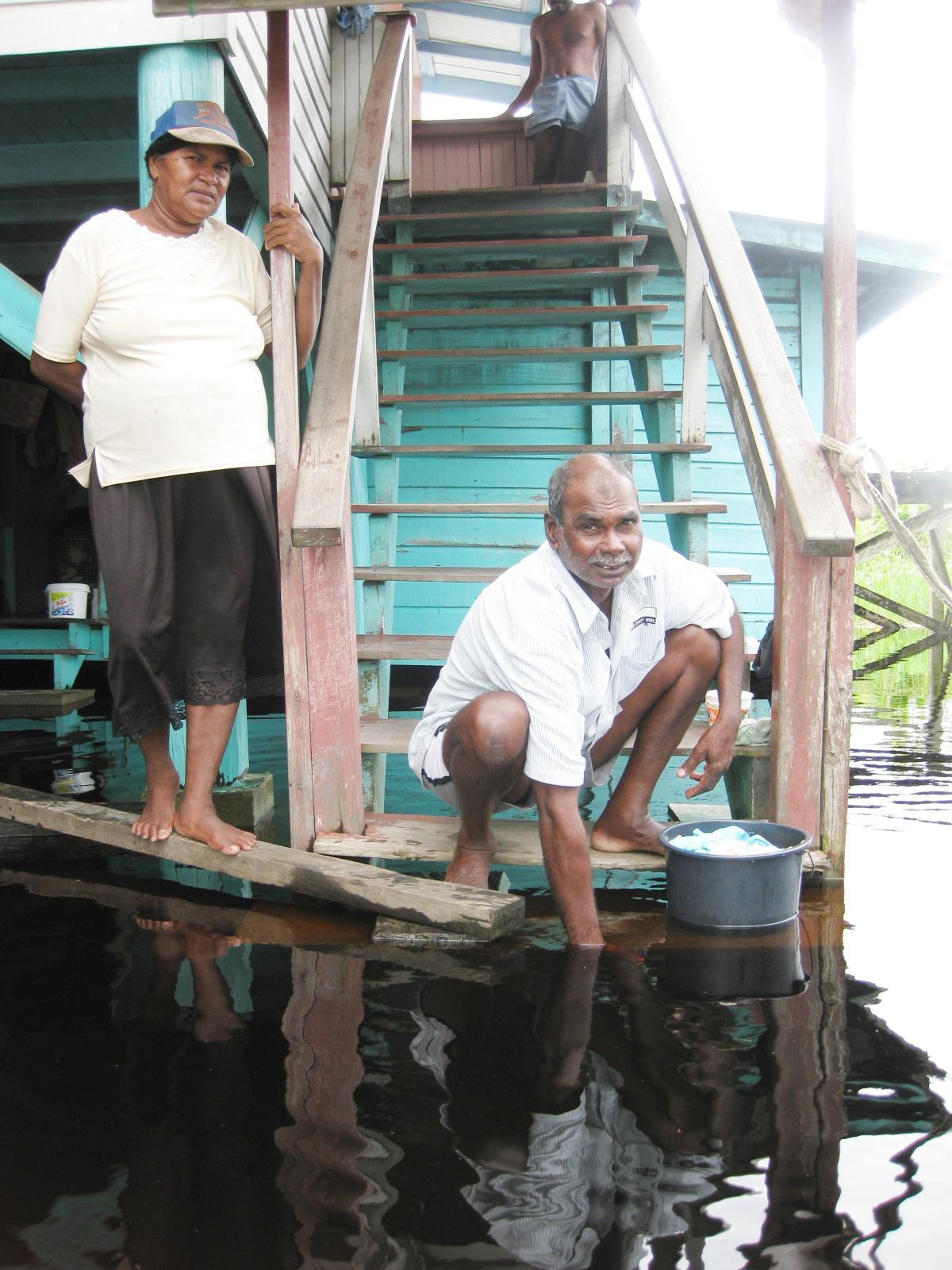
They said “three times a year we get flood” and they tried to battle it this time by making a “high dam with we lil savings but even that duck out and we deh pun we bearings – this is too much disaster.”
They lost 400 roots bora, over 300 plantain suckers, 100 roots beans, 50 squash plants and 200 peppers. Lakhrajie said she has to stand in her canoe to cook on her fireside in her flooded yard because “me nah have kero to cook with…”
Ramkellawan was worried that with the constant flooding his house would fall because it has already started to sink at the back. He said that boats with big engines would pass too fast in the creek and “splash big waves and dem does lash against me house.”
Another farmer, Sugrim Sarju showed this newspaper a spot on a post where he had marked the level of the 2006 flood. Water is already almost two inches above that mark.
He, like other farmers were pleased with the President’s announcement that he would dig the canal at Hope. He said he was part of a delegation that had advised the government since 2000 to make the canal.
“Like they de shame to take farmers’ advice and now, nine years later then they willing to make the canal. I think they [government] should compensate the farmers; this is not God flood, this is manmade,” Sarju said.
He was grateful for excavation work from the government to build up a portion of his farm on the left bank of the creek to about seven ft. high. While he has lost all his other crops he was pleased that 1,000 roots of bora and 500 roots of peppers that were on that section have been safe so far.

He said the bora is now blooming, while he had already started to reap 200 lbs of peppers per week. The pepper, he said is a long-term crop and he could continue to reap until next year. However, he is aware that the section is under threat from flooding as well and is afraid that it would not be long before he loses that as well.
He said he heard on television that shelters would be set up for flood victims and while noting that it is a good idea he said persons would prefer to sleep in their own homes. However, he said they could visit the shelters for meals.
‘Watching de
water’
Over at Grass Hook, 76-year-old Pramdass Ramkissoon, his wife Doris and their son and grandson; Dharamdeo and Jewan were sitting under their house “watching de water.”
Dharamdeo said he had spent a lot of time “searching fuh mud and fulling up this bottom-house with me hand and rainfall alone don’t duck here.”
The family said that up to last Tuesday the place was dry but after intense rainfall during the night they woke up to floodwaters in that section the following morning.
Doris said she owns seven cows which she takes care of around the yard but when the cows had to be carried to “swim the creek” to go to a high area yesterday morning “me start fuh cry because me don’t know wha gon happen to them.”
Dharmendra said they have to catch fish to survive and “we tie five and six seines and sometimes for two or three days we barely get about two fish; this is real starvation.”
Chitrawattie Ramcharitar, a widow, said she “went into a lot of expense” to cultivate her squash, watermelon and other crops. She was looking forward to reaping her watermelon this weekend and was distressed that “everything gone.”
The woman said if the water rose another two inches it would get into her house. She had not heard about any shelter being set up but said she would prefer to remain at her house and be given the food items to cook for herself and daughter.
Her son and his wife have already moved out of the creek with their baby.
Another resident, Khemraj Ganchand on the left bank of the creek who lost his 4,000 roots of bora, 6,000 tomato plants, 200 roots squash, 626 pepper plants and 500 same (beans) plants said he was looking to migrate because he could not face another flood.
He said Mahaica Creek produces the best cash crop especially bora and that a lot of people from out of the creek would suffer for vegetables as a result of the farmers’ losses.
He acknowledged that government “don’t have anywhere to put the water but they just come and give we a lil hamper and we don’t know when we gon see them back.”
He also stressed that “government spent billions of dollars in the conservancy and they still can’t fix the problem.” He said that in 2005 residents again suggested to government officials about digging the canal and they had agreed…
Just after Grass Hook, a farm belonging to a large-scale livestock farmer, Mr. Harris; a German national who spent a lot of money to empoulder his huge plot, was also under more than knee-deep water. He also lost about 17 sheep to the flood.
Meanwhile, along the Number 10 Mahaica Creek road, rice farmer Govinram Umrao said he has been spending a lot of money in a battle to save over 60 acres of rice. He had already lost 70 acres and is afraid for the 60 acres as well.
“Duck-weed” has also taken over the crops belonging to other rice farmers in the creek. It was also observed that farmers had left their livestock along the De Hoop road to escape the floodwaters.
The water level has risen significantly in the villages as well and over at Little Biaboo, it had started to flow over the road.





